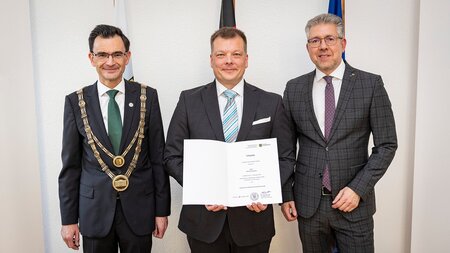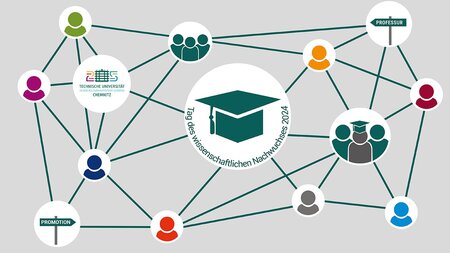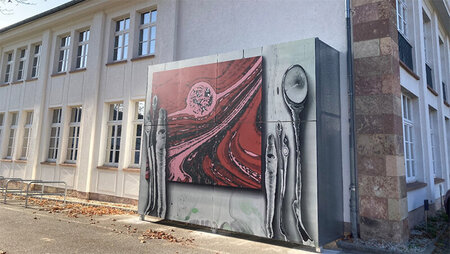New Collaborative Research Center Approved at Chemnitz University of Technology
The Hybrid Societies Collaborative Research Center will investigate future forms of interaction between humans and technology – The German Research Foundation will fund its establishment with ten million euros
-

The Hybrid Societies Collaborative Research Center at Chemnitz University of Technology will investigate and optimise humans’ interaction with embodied digital technologies, which include robots and self-driving vehicles. Photographic: Jacob Müller -

In hybrid societies, humans will need to coordinate with autonomously acting embodied digital technologies, which include robots and self-driving vehicles. Photo: Jacob Müller
The German Research Foundation (DFG) has approved the establishment of the Hybrid Societies Collaborative Research Center at Chemnitz University of Technology, where 30 professors and senior researchers from the university will investigate topics pertaining to “Hybrid Societies – Humans Interacting with Embodied Technologies”. This research collaboration includes, for example, how people can efficiently and safely coordinate with autonomous vehicles and robots that they encounter in public spaces. Collaborative research centers are long-term research facilities that can run for as long as twelve years and situate university institutes in a collaborative, interdisciplinary research programme. In its first four years, the collaborative research center Hybrid Societies is funded with ten million euros. The spokesperson of the collaborative research center is Prof. Dr. Georg Jahn, Professor of Applied Geropsychology and Cognition at Chemnitz University of Technology.
“I am really pleased with this great achievement, and I offer heartfelt congratulations to everyone involved. The establishment of the Hybrid Societies Collaborative Research Center, which involves representatives from all eight faculties at Chemnitz University of Technology, is an outstanding success – not just for each individual contributing researcher, but also for our core competency of Humans and Technology, for all faculties, and for the university as a whole – I would like to thank all colleagues who contributed to this success in a special way. Of course, I would also like to congratulate Georg Jahn and his team for their great commitment,” says Prof. Dr. Gerd Strohmeier, President of Chemnitz University of Technology.
The funded projects focus on coordination with embodied digital technologies
People coordinate their actions effortlessly – based on their ability to communicate, to infer intentions, and to control movement. They can skillfully evade each other, or hand over items without any hesitation. “For encounters and cooperation in hybrid societies to be as fluid as possible, it is necessary to achieve similar coordination between humans and embodied technologies, such as robots,” explains Jahn. This requires expertise about human communication and technical competencies. For this reason, researchers from Psychology, Engineering, Computer Science, Human Movement Science, Linguistics, Gesture Research, Sociology, Physics, Mathematics and Law are working cooperatively in the Hybrid Societies Collaborative Research Center.
“The scientific questions that are posed concern new forms of human-technology interaction that emerge from the rapid development of embodied technologies. Embodied technologies include those that are partially or temporarily controlled by humans, such as bionic prostheses or telepresence robots,” adds the acting collaborative research center spokeswoman Prof. Dr. Ulrike Thomas, Professor of Robotics and Human Machine Interaction. Avatars in virtual reality are further examples of artificial bodies that people encounter, and which are controlled via embodied technology. “For fluid coordination between people and embodied technologies, capabilities and intentions must be inferred based on bodily appearance and movement patterns,” says Thomas. Equally important as a research focus in the Hybrid Societies Collaborative Research Center is the direct communication by gaze, language, and gestures.
With the new collaborative research center at Chemnitz University of Technology, a graduate college will be established that will promote interdisciplinary cooperation and offer special qualification opportunities to doctoral students.
The homepage of the Hybrid Societies Collaborative Research Center: www.hybrid-societies.org
For further information on the Hybrid Societies Collaborative Research Center, please contact Prof. Dr. Georg Jahn, Professorship of Applied Geropsychology and Cognition: Phone: +49(0)371 531-36338, Email: georg.jahn@psychologie.tu-chemnitz.de, or Prof. Dr. Ulrike Thomas, Professorship of Robotics and Human-Machine Interaction: Phone: +49(0)371 531-31648, Email: ulrike.thomas@etit.tu-chemnitz.de.
(Translation: Jeffrey Karnitz)
Mario Steinebach
26.11.2019





